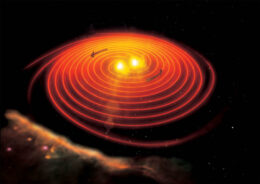Is the gamma-ray burst GRB 191019A a typical long-duration gamma-ray burst from a dying massive star, an anomalously long burst from colliding objects, or something else entirely?
Powerfully Mysterious

An illustration of a neutron star merger, which is one way to create a gamma-ray burst. [ESA 2002/Medialab]
With time and accumulating data, these length-based classifications have become associated with different sources: long gamma-ray bursts seem to arise from core-collapse supernovae, when the curtain closes on stars substantially more massive than the Sun, and short gamma-ray bursts seem to happen when two extraordinarily dense objects like neutron stars collide. However, as the tally of gamma-ray bursts has grown, so has the list of events that fail to fall neatly into these two categories.

This illustration depicts GRB 191019A as resulting from the collision of two stars within the dense environment of a galactic nucleus. Today’s article suggests that the event took place far closer to the galaxy’s supermassive black hole. [International Gemini Observatory/NOIRLab/NSF/AURA/M. Garlick/M. Zamani; CC BY 4.0]
An Alternative Hypothesis
In October 2019, researchers discovered the gamma-ray burst GRB 191019A, which lasted just over a minute and appeared at first to be a standard long burst arising from a supernova. Later, this interpretation was called into question: no associated supernova emission was spotted, the burst was slightly fainter than expected for its type, and its host galaxy wasn’t as vigorously star forming as the galactic hosts of long gamma-ray bursts tend to be. Together, these findings suggested that GRB 191019A may be part of an emerging class of gamma-ray bursts that arise from colliding objects despite lasting longer than two seconds.
In a recent article, a team led by Robert Eyles-Ferris (University of Leicester) explored another possibility: that GRB 191019A isn’t a gamma-ray burst at all. Instead, Eyles-Ferris’s team proposed that rather than a supernova or a cosmic collision, what caused the event was a star that wandered too close to a supermassive black hole and was summarily torn apart — a tidal disruption event.
Examining a Rare Phenomenon
Some aspects of GRB 191019A, such as its location near the center of a galaxy, naturally align with this alternative hypothesis. Other factors, such as the event’s length, seem at odds with this explanation — tidal disruption events tend to play out over the course of months rather than minutes. Eyles-Ferris and collaborators hypothesized that GRB 191019A isn’t just any tidal disruption event but an ultra-deep one, in which the doomed star is so stretched out by the black hole’s tidal forces that the star wraps all the way around the black hole and collides with itself, launching a relativistic jet in the process.
Using a mathematical model, Eyles-Ferris and coauthors showed that GRB 191019A’s luminosity and time scale are consistent with what’s expected for an ultra-deep tidal disruption event. If this hypothesis is correct, GRB 191019A is the first example of an ultra-deep tidal disruption event and just the fifth known jetted tidal disruption event. As rare as these events are likely to be, other instances will crop up somewhere in the vastness of the universe, and Eyles-Ferris’s team has a way to pick them out: a flash of low-energy X-rays that erupts the moment the star collides with itself.
Citation
“Ultradeep Cover: An Exotic and Jetted Tidal Disruption Event Candidate Disguised as a Gamma-ray Burst,” R. A. J. Eyles-Ferris et al 2024 ApJL 965 L20. doi:10.3847/2041-8213/ad3922

